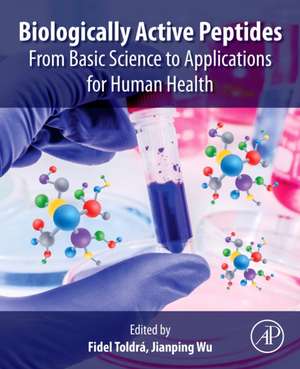Biologically Active Peptides: From Basic Science to Applications for Human Health
Editat de Fidel Toldra, Jianping Wuen Limba Engleză Paperback – 25 iun 2021
Later, applications across disease areas and medical specialties are examined in-depth, including the use of bioactive peptides in treating obesity, diabetes, osteoporosis, mental health disorders, food allergies, and joint health, among other disorders, as well as bioactive peptides for sensory enhancement, sports and clinical nutrition, lowering cholesterol, improving cardiovascular health, and driving advances in biotechnology.
- Discusses the latest advances in bioactive peptide chemistry, functionality and analysis
- Offers step-by-step instruction in applying new technologies for peptide extraction, protection, production and encoding, as well as employing bioactive peptide sequencing and bioactivity assays in new research
- Effectively links basic peptide chemistry, human biology and disease
- Features chapter contributions from international experts across disciplines and applications
Preț: 932.66 lei
Preț vechi: 1193.35 lei
-22% Nou
Puncte Express: 1399
Preț estimativ în valută:
178.52€ • 193.98$ • 150.05£
178.52€ • 193.98$ • 150.05£
Carte tipărită la comandă
Livrare economică 14-28 aprilie
Preluare comenzi: 021 569.72.76
Specificații
ISBN-13: 9780128213896
ISBN-10: 0128213892
Pagini: 818
Ilustrații: 150 illustrations (100 in full color)
Dimensiuni: 191 x 235 mm
Greutate: 1.66 kg
Editura: ELSEVIER SCIENCE
ISBN-10: 0128213892
Pagini: 818
Ilustrații: 150 illustrations (100 in full color)
Dimensiuni: 191 x 235 mm
Greutate: 1.66 kg
Editura: ELSEVIER SCIENCE
Public țintă
Active researchers in biochemistry, medical chemistry, molecular biology, cell biology, pharmacology, nutrition, and food science; clinician scientists; researchers in industry and pharmaStudents of biochemical sciences; clinicians across disease specialties
Cuprins
1. Bioactive peptides in health and disease: An overview
2. Enzymatic mechanisms for the generation of bioactive peptides
3. Methodologies: Novel technologies in bioactive peptides production and stability
4. Methodologies for extraction and separation of short-chain bioactive peptides
5. Methodologies for peptidomics: Identification and quantification
6. Methodologies for bioactivity assay: Biochemical study
7. Methodologies for bioactivity assay: Cell study
8. Methodologies for bioactivity assay: Animal study
9. Methodologies for bioavailability assessment
10. Methodologies for Studying the Structure-function Relationship of Food-derived Peptides with Biological
Activities
11. Methodologies for study of Mechanisms of action: Biochemistry approach
12. Methodologies for study of Mechanisms of action: Multi-omic approach
13. Methodologies for study of mechanisms of action: Gene editing approach
14. Databases of bioactive peptides
15. Technologies for bioactive peptides protection and delivery
16. Plant sources of bioactive peptides
17. Generation of Bioactivities from Proteins of Animal Sources by Enzymatic Hydrolysis and the Maillard Reaction
18. Sustainable alternative sources of bioactive peptides
19. Applications in nutrition: Mineral-binding
20. Applications in nutrition: Clinical nutrition
21. Applications in nutrition: Sport nutrition
22. Applications in nutrition: Cholesterol lowering activity
23. Applications in nutrition: Peptides as taste enhancers
24. Applications in medicine: Cardiovascular benefit (ACE and renin inhibitory peptides)
25. Applications in medicine: Diabetes prevention (hypoglucemic peptides)
26. Applications in medicine: Obesity (including satiety control)
27. Food-derived osteogenic peptides towards osteoporosis
28. Applications in medicine: Mental health
29. Applications in medicine: Food allergy
30. Applications in medicine: Joint health
31. Applications in food technology: Antimicrobial peptides
2. Enzymatic mechanisms for the generation of bioactive peptides
3. Methodologies: Novel technologies in bioactive peptides production and stability
4. Methodologies for extraction and separation of short-chain bioactive peptides
5. Methodologies for peptidomics: Identification and quantification
6. Methodologies for bioactivity assay: Biochemical study
7. Methodologies for bioactivity assay: Cell study
8. Methodologies for bioactivity assay: Animal study
9. Methodologies for bioavailability assessment
10. Methodologies for Studying the Structure-function Relationship of Food-derived Peptides with Biological
Activities
11. Methodologies for study of Mechanisms of action: Biochemistry approach
12. Methodologies for study of Mechanisms of action: Multi-omic approach
13. Methodologies for study of mechanisms of action: Gene editing approach
14. Databases of bioactive peptides
15. Technologies for bioactive peptides protection and delivery
16. Plant sources of bioactive peptides
17. Generation of Bioactivities from Proteins of Animal Sources by Enzymatic Hydrolysis and the Maillard Reaction
18. Sustainable alternative sources of bioactive peptides
19. Applications in nutrition: Mineral-binding
20. Applications in nutrition: Clinical nutrition
21. Applications in nutrition: Sport nutrition
22. Applications in nutrition: Cholesterol lowering activity
23. Applications in nutrition: Peptides as taste enhancers
24. Applications in medicine: Cardiovascular benefit (ACE and renin inhibitory peptides)
25. Applications in medicine: Diabetes prevention (hypoglucemic peptides)
26. Applications in medicine: Obesity (including satiety control)
27. Food-derived osteogenic peptides towards osteoporosis
28. Applications in medicine: Mental health
29. Applications in medicine: Food allergy
30. Applications in medicine: Joint health
31. Applications in food technology: Antimicrobial peptides
